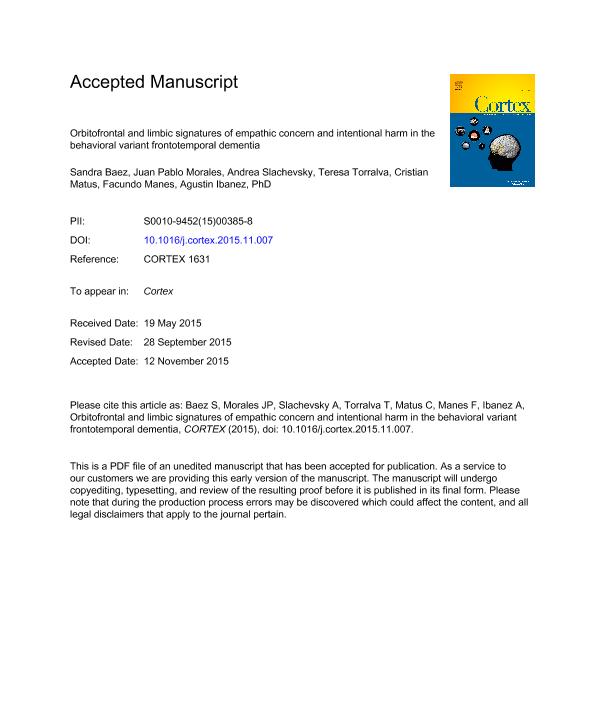Mostrar el registro sencillo del ítem
dc.contributor.author
Báez Buitrago, Sandra Jimena

dc.contributor.author
Morales, Juan Pablo

dc.contributor.author
Slachevsky, Andrea
dc.contributor.author
Torralva, Teresa

dc.contributor.author
Matus, Cristian
dc.contributor.author
Manes, Facundo Francisco

dc.contributor.author
Ibañez, Agustin Mariano

dc.date.available
2018-03-14T18:02:34Z
dc.date.issued
2016-02
dc.identifier.citation
Báez Buitrago, Sandra Jimena; Morales, Juan Pablo; Slachevsky, Andrea; Torralva, Teresa; Matus, Cristian; et al.; Orbitofrontal and limbic signatures of empathic concern and intentional harm in the behavioral variant frontotemporal dementia; Elsevier Masson; Cortex; 75; 2-2016; 20-32
dc.identifier.issn
0010-9452
dc.identifier.uri
http://hdl.handle.net/11336/38737
dc.description.abstract
Perceiving and evaluating intentional harms in an interpersonal context engages both cognitive and emotional domains. This process involves inference of intentions, moral judgment, and, crucially, empathy towards others' suffering. This latter skill is notably impaired in behavioral variant frontotemporal dementia (bvFTD). However, the relationship between regional brain atrophy in bvFTD and deficits in the above-mentioned abilities is not well understood. The present study investigated how gray matter (GM) atrophy in bvFTD patients correlates with the perception and evaluation of harmful actions (attribution of intentionality, evaluation of harmful behavior, empathic concern, and moral judgment). First, we compared the behavioral performance of 26 bvFTD patients and 23 healthy controls on an experimental task (ET) indexing intentionality, empathy, and moral cognition during evaluation of harmful actions. Second, we compared GM volume in patients and controls using voxel-based morphometry (VBM). Third, we examined brain regions where atrophy might be associated with specific impairments in the patient group. Finally, we explored whether the patients' deficits in intentionality comprehension and empathic concern could be partially explained by regional GM atrophy or impairments in other relevant factors, such as executive functions (EFs). In bvFTD patients, atrophy of limbic structures (amygdala and anterior paracingulate cortex - APC) was related to impairments in intentionality comprehension, while atrophy of the orbitofrontal cortex (OFC) was associated with empathic concern deficits. Intentionality comprehension impairments were predicted by EFs and orbitofrontal atrophy predicted deficits in empathic concern. Thus, although the perception and evaluation of harmful actions are variously compromised in bvFTD, deficits in empathic concern may be central to this syndrome as they are associated with one of the earliest atrophied region. More generally, our results shed light on social cognition deficits in bvFTD and may have important clinical implications.
dc.format
application/pdf
dc.language.iso
eng
dc.publisher
Elsevier Masson

dc.rights
info:eu-repo/semantics/openAccess
dc.rights.uri
https://creativecommons.org/licenses/by-nc-nd/2.5/ar/
dc.subject
Bvftd
dc.subject
Empathy
dc.subject
Gray Matter Atrophy
dc.subject
Intentional Harm
dc.subject
Intentionality Comprehension
dc.subject
Moral Judgment
dc.subject.classification
Neurociencias

dc.subject.classification
Medicina Básica

dc.subject.classification
CIENCIAS MÉDICAS Y DE LA SALUD

dc.title
Orbitofrontal and limbic signatures of empathic concern and intentional harm in the behavioral variant frontotemporal dementia
dc.type
info:eu-repo/semantics/article
dc.type
info:ar-repo/semantics/artículo
dc.type
info:eu-repo/semantics/publishedVersion
dc.date.updated
2018-03-12T19:23:45Z
dc.journal.volume
75
dc.journal.pagination
20-32
dc.journal.pais
Francia

dc.journal.ciudad
París
dc.description.fil
Fil: Báez Buitrago, Sandra Jimena. Universidad Diego Portales; Chile. Consejo Nacional de Investigaciones Científicas y Técnicas. Oficina de Coordinación Administrativa Houssay. Instituto de Neurociencia Cognitiva. Fundación Favaloro. Instituto de Neurociencia Cognitiva; Argentina
dc.description.fil
Fil: Morales, Juan Pablo. Universidad Diego Portales; Chile
dc.description.fil
Fil: Slachevsky, Andrea. Universidad de Chile; Chile
dc.description.fil
Fil: Torralva, Teresa. Instituto de Neurología Cognitiva; Argentina. Universidad Diego Portales; Chile
dc.description.fil
Fil: Matus, Cristian. Fundación Médica San Cristobal; Chile. Hospital de Carabineros de Chile; Chile
dc.description.fil
Fil: Manes, Facundo Francisco. Consejo Nacional de Investigaciones Científicas y Técnicas. Oficina de Coordinación Administrativa Houssay. Instituto de Neurociencia Cognitiva. Fundación Favaloro. Instituto de Neurociencia Cognitiva; Argentina. Universidad Diego Portales; Chile. Macquarie University; Australia
dc.description.fil
Fil: Ibáñez Barassi, Agustín Mariano. Macquarie University; Australia. Consejo Nacional de Investigaciones Científicas y Técnicas. Oficina de Coordinación Administrativa Houssay. Instituto de Neurociencia Cognitiva. Fundación Favaloro. Instituto de Neurociencia Cognitiva; Argentina. Universidad Diego Portales; Chile. Universidad Autónoma del Caribe; Colombia
dc.journal.title
Cortex

dc.relation.alternativeid
info:eu-repo/semantics/altIdentifier/doi/http://dx.doi.org/10.1016/j.cortex.2015.11.007
dc.relation.alternativeid
info:eu-repo/semantics/altIdentifier/url/https://www.sciencedirect.com/science/article/pii/S0010945215003858
Archivos asociados
